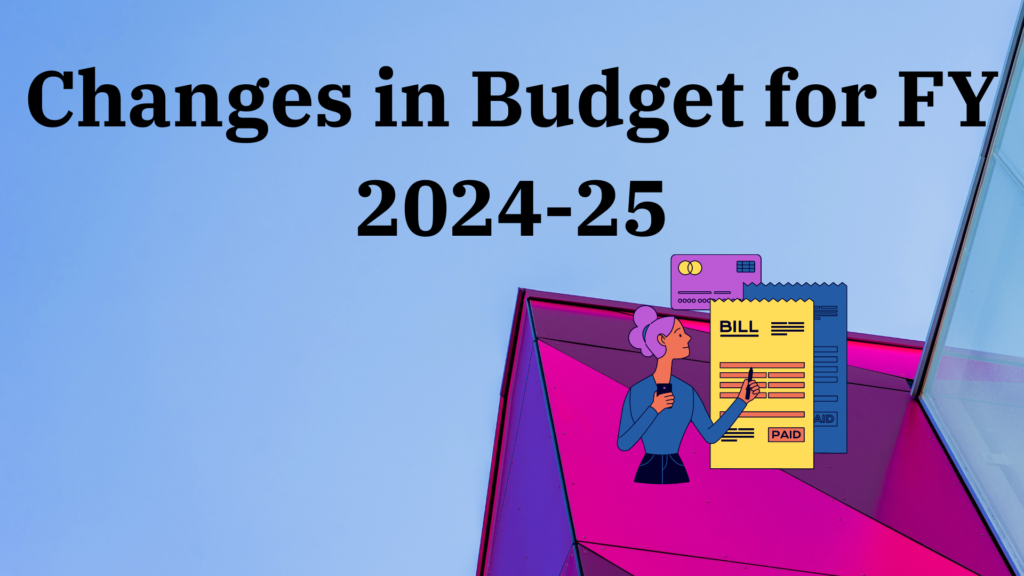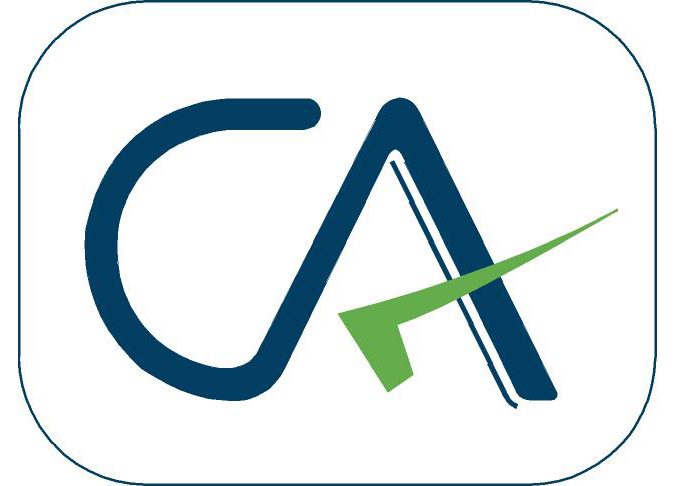Changes in Budget for FY 2024-25 (After passing the Budget in 1st Feb)

In India, businesses and the general people look forward to Budget Day with great anticipation, as they want to know what policies and programs may be of use to them. An interim budget has been established for budget 2024 this year due to the impending elections. To the public’s great satisfaction, the honorable Finance Minister, Smt. Nirmala Sitharaman, has continued to deliver on plans and benefits.
The FM declared on February 1, 2024, that “Viksit Bharat Budget 2024” will be the topic of this year’s budget. She reaffirmed that Atmanirbhar Bharat remains the nation’s goal. Simultaneously, the Interim Budget 2024 would prioritize the welfare and ambitions of the Annadata (farmers), Gareeb (poor), Mahila (women), and Yuva (youth).
Interim Budget 2024: Proposals for Direct Taxes
- The FM declared that the direct tax rates for FY 2024–2025 will remain the same. Under the new tax system, those making up to Rs. 7 lakh will not be required to pay any taxes.
- Existing domestic enterprises will pay corporation taxes at a rate of 22%, while select newly established manufacturing companies would pay taxes at a rate of 15%.
- The FM declared that throughout the past ten years, direct tax collections have more than tripled, while the number of return filers has increased by 2.4 times.
- Conversely, the mean duration for processing tax returns has decreased from 93 days during 2013–14 to 10 days during 2023–24.
- The FM has suggested extending the period by which certain tax benefits for investments made by sovereign wealth funds and pension funds, as well as a tax exemption for some IFSC units that expire on March 31, 2024, may be claimed. This has been extended to March 31, 2025.
Goods and Services Tax in the Interim Budget 2024
- The FM declared that in FY24, the gross GST collection on average has increased to Rs. 1.66 lakh crore each month.
- The tax buoyancy of state revenue increased from 0.72 in the 2012–16 fiscal year to 1.22 in the 2017–23 post–GST fiscal year.
- The FM declared that for FY 2024–2025, import tariffs and customs rates will remain the same.
Viksit Bharat 2047 Roadmap: Interim Budget 2024
The Viksit Bharat theme for this year’s budget saw the government envisioning a developed India by 2047. Viksit Bharat Budget 2024’s four pillars are “Annadata” (Farmers), “Mahilayen” (Women), “Yuva” (Youth), and “Garib” (Poor). In view of the inclusive growth plan that prioritizes people, the Finance Minister declared:
- The physical, digital, and social infrastructures will all see significant change.
- Formalization and financial inclusion will be encouraged by digital public infrastructure, or DPI.
- With the GST, the government intends to broaden and deepen the tax base.
- Credit, investment, and savings all returned to normal as a result of a strengthened banking sector.
- The establishment of GIFT IFSC, a strong gateway for international capital and financial services for the economy, is planned.
- Proactive inflation control is planned.
Change in Amrit Kaal’s strategy as Kartavya Kaal in the Interim Budget 2024
Green energy and sustainable development
The Finance Minister pledged to achieve “Net Zero” under Amrit Kaal by 2070, highlighting the need of sustainable development. Regarding this, the FM suggested:
financing for the viability gap in the initial one gigawatt capacity of offshore wind energy harvesting.
- Construction of a 100 MT coal gasification and liquefaction capacity by 2030
- Compressed biogas, PNG, and CNG must be blended gradually and for household use.
- Funding for the purchase of equipment for aggregating biomass
- Additionally, rooftop solarization will be implemented, enabling up to 300 units of free electricity per month for one crore people.
- Additionally, the government intends to assist the production and charging of electric vehicles in order to enhance the ecosystem surrounding e-vehicles and implement e-buses for public transportation.
- A new biomanufacturing and biofoundry initiative will be introduced to promote environmentally sustainable substitutes.
- Under the SNLP program, 1.3 crore LED street lights would be installed.
- The goal of the Blue Economy 2.0 initiative is to revive and modify coastal mariculture and aquaculture.
Investment and Infrastructure
- Under the PM Gati Shakti, the government intends to carry out three main railway corridor programs: the energy, minerals, and cement corridor; the port connection corridor; and the high traffic density corridor. It will lower expenses and increase the effectiveness of logistics.
- Bilateral investment treaties that will be negotiated will be used to encourage foreign investment.
- Expansion of current airports and all-encompassing construction of new airports funded by the UDAN program.
- Urban change will be brought about via the Metro rail and NaMo Bharat initiatives.
Development That Is Inclusive
With an ambitious District Programme to help states expand more quickly and create jobs, the FM emphasized the need for equitable development under Amrit Kaal. Regarding this,
Medical Care
- Girls between the ages of 9 and 14 are being actively encouraged by the government to get vaccinated against cervical cancer.
- The Saksham Anganwadi and Poshan 2.0 program aims to promote early childhood care and development, nutrition delivery, and anganwadi center upgradation as quickly as possible.
- Mission Indradhanush plans to launch a U-WIN platform for immunization campaigns.
- All ASHA, Anganwadi workers, and assistants would have expanded access to health care under the Ayushman Bharat initiative.
- A committee will be established to research the challenges associated with establishing more medical institutions in India.
House
- The goal of the Pradhan Mantri Awas Yojana (Grameen) is almost reached: 3 crore dwellings, plus an extra 2 crore over the following five years.
- A program called “Housing for the Middle Class” will be introduced to encourage middle-class people to purchase or construct their own homes.
Travel
- States will be urged to build famous tourism destinations in order to draw tourists and foster local commercial prospects.
- States are to be given long-term, interest-free loans to promote development.
- Initiatives pertaining to port accessibility, tourism facilities, and facilities will be implemented on islands, encompassing Lakshadweep.
Agriculture and Food Processing
- The government intends to encourage both public and private investment in post-harvest operations.
- All agroclimatic zones will see an expansion in the use of Nano-DAP.
- To attain atma nirbharta for oilseeds, the Atmanirbhar Oilseeds Abhiyan approach will be developed.
- It is necessary to have a thorough plan for the development of dairy products.
- In order to quadruple exports, increase employment possibilities, and improve aquaculture output, the Pradhan Mantri Matsya Sampada Yojana will be implemented more aggressively.
Full Budget vs. Interim Budget:
Let’s first clarify what an interim budget and a full budget are. An interim budget fills the gaps until a new government is formed, as opposed to a full-fledged budget that covers the complete fiscal year. Consider it a short-term budget that is centered around regular spending and ongoing initiatives.
Expectations for the budget in 2024:
In order to keep things running smoothly till the elections, Finance Minister Nirmala Sitharaman herself has toned down expectations, saying the February budget will be very minimal. This entails concentrating on necessary spending and making little changes to policies. Nonetheless, we anticipate the following from the 2024 budget:
Reduction of ESOP taxes: Employers have started encouraging staff members to join startups by offering them ESOPs as a reward. This year is predicted to see a large number of startups go public. Therefore, it would be beneficial for startups if the government made the ESOP tax laws more employee-friendly. Additionally, this action contributes to the growth of jobs in startups.
Raising the house loan interest cap: Currently, there is a maximum deduction of Rs. 2,00,000 for interest repayment on a loan taken out to purchase a self-occupied property. But this restricts the potential buyer’s ability to purchase a property. Property prices have climbed dramatically in most cities, which has led to an increase in house loan interest payments. Thus, the Rs. 2,00,000 cap needs to be considered.
Allowing interest on home loans under the new tax structure: The interest paid on a house loan for a property that is rented out is deductible under the new tax law, but not for a property that is occupied by the owner. It is anticipated that the new tax regime will include house loan interest repayment as a means of encouraging home purchasers. Additionally, it might increase the new tax regime’s acceptability.
Raising the 80D deduction cap: As the premium amount grows on a periodic basis, raise the Sec. 80D limit for regular individuals from 25,000 to 50,000, and for senior people from 50,000 to 75,000.
80D’s incorporation into the new tax system: Given the urgent need for medical insurance, permitting the deduction of medical insurance costs under the new tax system will expand coverage and boost public acceptance of the system.
The HRA Exemption listing for Bengaluru as a metro city: Bengaluru is classified as a non-metro for income tax reasons, which limits HRA deductions to 40%, even though it is recognized as a metro city by the constitution. This is in contrast to other metro cities. The demand is for it to be raised to 50%.
Regarding indirect taxes:
Choice to amend GST returns: Only in later return periods may errors in filed returns be corrected. We anticipate that allowing returns to be revised will benefit both the department and the taxpayers by assisting in the reduction of the multitude of notices and notifications. This is what GSTN is aiming for, and if the government provides APIs, we will be able to understand its dynamics.
E-billing for business-to-consumer sales: Better compliance and a further decrease in tax evasion would result from extending this rule to B2C transactions. But this would also mean more work for firms to comply with, particularly smaller ones, who might need to modernize their technology in order to meet these standards.
Final Thoughts
The FM declared in Budget 2024 that this year’s budget would have the theme “Viksit Bharat Budget 2024,” which aims to see a developed India by 2047. Viksit Bharat’s four pillars will be the “Annadata” (Farmers), “Mahilayen” (Women), “Yuva” (Youth), and “Garib” (Poor).
The FM also emphasised the change from Amrit Kaal to Kartavya Kaal, with a focus on inclusive development, infrastructure and investment, agriculture, and food processing.
The FM further declared that the same direct tax rates would be maintained in FY 2024–2025. Under the new tax system, those making up to Rs. 7 lakh will not be required to pay any taxes. Existing domestic enterprises will pay corporation taxes at a rate of 22%, while select newly established manufacturing companies would pay taxes at a rate of 15%.
